
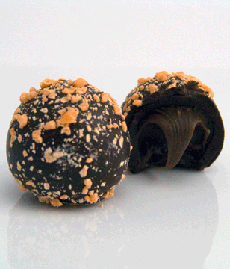
The original French truffle was a ball of ganache, rolled in a cocoa coating; later chopped nuts and confectioners’ sugar were added as coatings. Later, chocolatiers enrobed the ganache ball in a chocolate shell, like the truffles above. Photo courtesy TheCholive.com.
March 2005
Last updated February 2010
|
 |
Chocolate Glossary
Chocolate Terms & Definitions: T
Here you’ll find terms including terroir, Theobroma cacao, Trinitario and truffle. If you think we should consider chocolate terms and definitions other than those we have provided, click on the Contact Us link on this page. Also enjoy our 60+ other food glossaries.
Use this index bar to visit other pages.
a b c d e f g h i j k l m n o p q r s t u v w x y z
This glossary is protected by copyright and cannot be reproduced in whole or part.
TABLETTE or CHOCOLAT EN TABLETTE
The French word for a chocolate bar for eating. See also bâton.
TEMPERING
Chocolate is not shiny on its own: It needs to go through a process called tempering to achieve its glossy appearance and a pleasant mouthfeel. This involves an alternating process of heating, cooling, and heating again to specific temperatures to stabilize the mixture to obtain the smooth, shiny texture and a good snap when broken. Well-tempered chocolate melts better in the mouth and ages better. The word “temper” refers to the way chocolate solidifies. Only the cocoa butter particles become melted: Sugar and cocoa powder remain solids suspended in the fluid cocoa butter. When the melted chocolate cools and becomes solid again, the cocoa butter particles form a crystalline structure. The evenness of distribution of cocoa butter, and the type of crystals they form, comprise the temper. Chocolate is in good temper if the cocoa butter is mixed thoroughly and evenly throughout and the particles have cooled uniformly and completely. If not tempered properly the finished chocolate will be dull and streaky with a tendency to bloom. The classic tempering method is to melt the chocolate until it is lump-free. Then 1/3 of the chocolate is poured onto a marble slab, spread and worked back and forth with a metal spatula until it becomes thick and reaches a temperature of about 80°F. This chocolate is then added back to the remaining 2/3 of the melted chocolate and stirred. The process is repeated until the entire mixture reaches 88° to 92°F for semi-sweet chocolate, 84° to 87°F for milk or white chocolate. Care must be taken not to over-temper chocolate, which returns it to its original state—grainy and susceptible to bloom.
TERROIR
Terroir, pronounced tur-WAH, is the French word for soil, land or terrain. It can be loosely translated as “a sense of place,” the sum of the effects that the environment has on the creation of what is grown there. It has long been used in wine and coffee analysis to denote the special characteristics of soil, geology, aspect and altitude that give the grape or bean its individuality. The term is now being used, appropriately, to describe cacao beans.
THEOBROMA CACAO
The botanical name for cacao tree, a tropical evergreen in the family Byttneriaceae. It is native to the Amazon basin, but now grows worldwide in a tropical belt 20° above and below the equator. The genus name, Theobroma, means “food of the gods” in Greek (Theo = god, broma = food). The name was bestowed in 1753 by Swedish naturalist Carolus Linnaeus (Carl von Linné), who was dissatisfied with the word cacao. The Theobroma gene probably dates back millions of years; the species Theobroma cacao is likely just be 10,000 to 15,000 years old. The International Germplasm Database of Cacao includes about 12,500 cacao clones; the three leading varietals are Criollo, Forastero and Trinitario. Their differences result from their pod structure, the color of their beans and the number of beans per pod. |
|
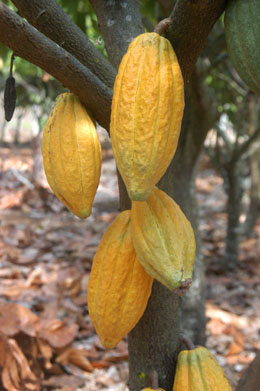
Criollo cabosses growing on the Theobroma cacao tree. It is not possible to determine the variety from the exterior pod; the beans inside need to be inspected. Photo courtesy of Amano Chocolate.
|
- The Criollo varietal is the cacao that was grown by the Mesoamerican civilizations; it is still the predominant cacao of Central and northern South America. The beans are thick and have white or pink cotyledons, low acid levels and low bitterness. The processed beans produce a smooth, very flavored cacao. However, the trees have low yields and are susceptible to disease. It has been estimated as comprising from 5% to .1% of the world’s cacao production.
- The Forastero varietal comes from the subspecies Theobroma cacao sphaerocarpum. It is believed to be indigenous to the northern Amazon River basin, in what is now Brazil. It has flat, violet-colored beans with moderate acidity and simple, earthy flavors. Forasteros are divided into two species, growing in the Amazonian Highlands and Lowlands respectively. The latter is the most commonly grown cacao in the world, representing about 90% of world production. It is the primary cacao of western Africa as well as Brazil. While Forasteros are known more for their hardiness and high yield than their flavor, a few subspecies produce cacao that can compete with Trinitario.
- The Trinitario is a hybrid of Criollo and Forastero beans that emerged after a hurricane destroyed the Criollo plantations in Trinidad in 1727. Thirty years later the Capuchin friars rebuilt their missions and planted some Forastero trees. Theobroma cacao hybridizes easily; soon the new Forastero trees hybridized with some remaining Criollo trees and the Trinitario varietal was born. Today, it is the primary cacao of the Caribbean. The Trinitario combines some flavor and sensory features of the Criollo bean with the strength and high yield of the Forastero bean. Trinitario flavor can be difficult to define in general terms due to the widely varying ratios of Criollo and Forastero beans. One can find spicy, earthy and fruity flavors in different subspecies, and cacao that is to highly acidic. According to Robert Steinberg, co founder of Scharffen Berger Chocolate Maker, even Trinitario beans that physically resemble Criollo beans, suggesting a high percentage of Criollo genes, often exhibit little of Criollo’s characteristic taste profile.
THEOBROMINE
A stimulant, one of the more than 400 compounds that comprise chocolate. The other major stimulant in chocolate is caffeine.
THICK
Thick, also called pasty, refers to the texture of the chocolate. In order to achieve optimum smoothness and avoid being thick, some brands add extra cocoa butter. Thickness can be due to different factors: (1) The the lower fat content of the beans. Generally, higher grade beans do not require a great amount of added cocoa butter due to their already higher level of fat. (2) Some purist brands don’t use lecithin for added fluidity because it can mask some subtle aromas and flavors. As a result, the chocolate will not melt as smoothly in the mouth and will seem “thicker” in texture. (3) Chocolate of high cacao content, 80% and above, will have a thicker texture due to the higher amount of cocoa liquor. This feature is virtually unavoidable unless extra cocoa butter is added.
TONKA BEAN
The tonka bean is the seed is the seed of Dipteryx odorata, a South American tree found in the region of French Guiana. It has the shape of an almond with the shriveled look of a raisin and is very fragrant. The flavor is reminiscent of vanilla, coffee and bitter almond, and it is popular with boutique chocolatiers and pâtissiers. The spice is actually illegal; Tonka beans contain a small amount of a substance called coumarin, which acts as a blood anticoagulant and is considered a drug. (The tonka bean is not an illegal food additive in the U.K. or France, among other countries.) |
|
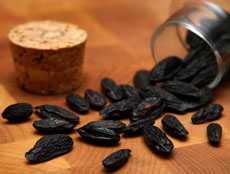
The Tonka bean is tasty, but not exactly legal. Photo by Mecredis | Fred Benenson, courtesy Wikimedia Commons.
|
However, an insignificant amount of coumarin would be ingested from food, and experts say it is not considered a health risk. It is used in perfume, and prior to being banned by the FDA in 1985, it was used to make vanilla extract and to flavor cigarettes.
TORRONE
Pronounced toe-ROW-nay, the Italian word for nougat.
TRINITARIO or TRINTARIO or TRINITARIOS
Trinitario cacao, a flavor cacao, is a hybrid of Criollo and Forastero cacao trees. Colorful pods range from lemon yellow to red-violet. Some Trinitario species are as prized as the finest Criollos. named after its place of origin, Trinidad. Either a disease of pandemic proportions or a hurricane—reports cite “natural disaster”—wiped out nearly the entire Criollo crop of Trinidad in 1727. In an attempt to restore the crops, plantations were replanted with Forastero trees, which hybridized with the remaining Criollos. The resulting new variety of cacao retained the delicate flavors of Criollo and the heartiness and disease resistance of Forastero. The varietal was not introduced to the continental Americas until the 19th century, first in Venezuela and later in Ecuador. Today, Trinitario cocoa is grown in all the areas where Criollo is grown: the Caribbean, Colombia, Mexico, Trinidad, Venezuela and in southeast Asia.
|
|
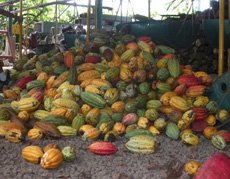
Above, Trinitario pods in Costa Rica. Photo courtesy Cocoa Puro. Below, clockwise from top, Forastero, Trinitario and Criollo pods. Photo courtesy Chocolat Céleste. Note that it is not possible to determine the type of cacao (Criollo, Forastero or Trinitario) based on the exterior appearance of the pod. Experts can tell by splitting the pod open and looking the beans.
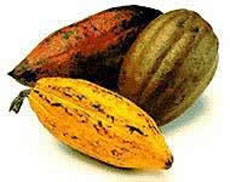
|
Trinitario cacao accounts for about 10% to 15% of current world production. Bars such as El Rey’s Carenero Superior, Domori’s Rio Caribe and Pralus bars from Colombia, Ecuador, Jamaica and Venezuela are made exclusively from Trinitario beans. See Theobroma cacao for more information.
Since Trinitario beans can take their flavor characteristics from either their Criollo or Forastero descendants, experts recommend that you look at the origin of the bean—the single origin characteristics—to understand the flavor of cacao, rather than look at the Trinitario bean as having a specific flavor profile. This is true with Criollo and Forastero beans as well, both because of prolific crossbreeding of the cacao trees, and because there are few “pure species” cacao farms: In many farms, trees from two different species will grow side by side due to nature.
TRUFFLE
The word truffle has several meanings in the world of candy because of their different countries of origin. It was invented in France as a small, rich chocolate made of ganache, often flavored and usually shaped into a ball. The original recipe, rolled in cocoa, was named after the black truffle fungus because of its physical resemblance. According to legend, the chocolate truffle was created in the kitchen of French culinary giant Auguste Escoffier during the 1920s. One day, as his stagiaire (apprentice) attempted to make pastry cream, he accidentally poured hot cream into a bowl of chocolate chunks rather than the bowl of sugared egg for which it was destined. As the chocolate and cream mixture hardened, he found he could work the chocolate paste with his hands to form a bumpy, lopsided ball. After rolling the new creation in cocoa powder, he was struck by their resemblance to the luxurious truffles from the French Périgord region and the Piedmont area of Italy. As the concept developed, different truffle textures were created by rolling the center ganache in white confectioners sugar or finely chopped nuts, like the classic assortment shown below; and the ganache was flavored with Champagne and liqueurs. |
|
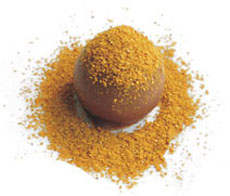
Vosges Haut Chocolat’s Naga truffle is ganache enrobed in milk chocolate and rolled in sweet curry powder. Below, Vosges’ Budapest truffle is rolled in sweet Hungarian paprika.
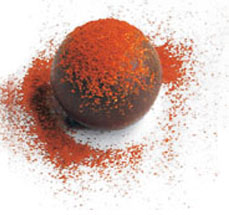 |
Today’s truffles can be coated in nouvelle spices like peppercorns, sweet curry and paprika and can be enrobed in couverture. In 1912, the Belgian chocolatier Jean Neuhaus invented the first hard chocolate shell, enabling chocolates with soft fillings. While he called them pralines (see the dual meaning), other chocolatiers referred to them as truffles because early filled chocolates were filled with ganache. As words evolve, the term truffle is often used to in America to describe any filled chocolate, and it becomes very confusing: chocolate cremes or assorted chocolates, e.g., would be more accurate. If the term is applied to a filled, hard-shell chocolate, the use should be limited to round shells filled with ganache, like the truffles from Vosges Chocolate shown above. See the history of chocolate truffles.
Continue To Next Page: Terms With U To Z
Go To Article Index Above
Lifestyle Direct, Inc. All rights reserved. Images are the copyright of their respective owners.

|










